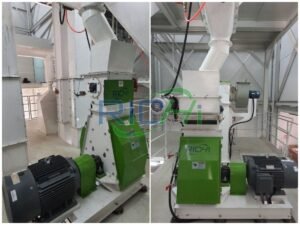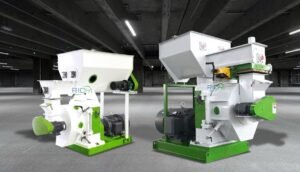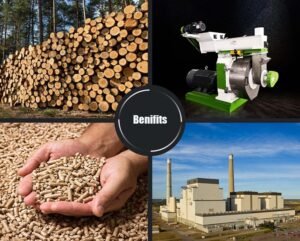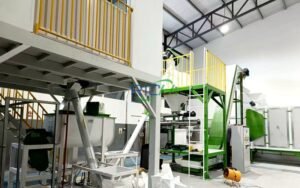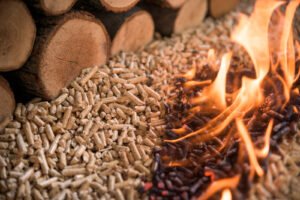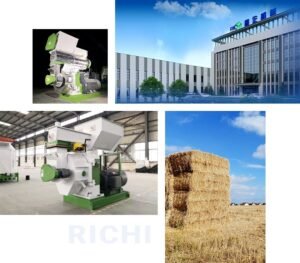
What Are Their Uses?The Straw Pellet Production Line is a versatile system designed to convert various types of agricultural and forestry residues into compact, high-density pellets. While primarily intended for straw, this production line can process a wide range of biomass materials, making it a valuable asset in the renewable energy and sustainable agriculture sectors.
This article explores the different types of pellets that can be produced using a Straw Pellet Production Line and their diverse applications.
Types of Pellets Processed by Straw Pellet Production Line
- Straw Pellets
As the name suggests, the primary material processed by this production line is straw from various crops such as wheat, rice, corn, and barley. Straw pellets are the most common output of these systems. - Hay Pellets
Similar to straw, hay from grasses can be effectively pelletized using this production line. - Corn Stalk Pellets
The stalks left after corn harvesting can be processed into pellets, utilizing what would otherwise be agricultural waste. - Soybean Stalk Pellets
Like corn stalks, soybean stalks can be pelletized after harvest. - Cotton Stalk Pellets
Cotton stalks, often considered waste in cotton production, can be transformed into useful pellets. - Wood Sawdust Pellets
While not the primary focus, many straw pellet production lines can also process wood sawdust into pellets. - Wood Chip Pellets
Small wood chips, often from forestry residues, can be pelletized using this equipment. - Bamboo Waste Pellets
Bamboo processing waste can be effectively converted into pellets. - Peanut Shell Pellets
The shells from peanut processing can be pelletized, turning this waste product into a valuable resource. - Sunflower Stalk Pellets
The stalks remaining after sunflower harvest can be processed into pellets.
Related post: Straw Pellet Machine
Uses of Pellets Produced by Straw Pellet Production Line
The pellets produced by a Straw Pellet Production Line have a wide range of applications across various industries:
- Biofuel for Heating
One of the primary uses of these pellets is as a renewable biofuel for heating systems. They can be used in:
- Residential pellet stoves
- Industrial boilers
- District heating systems
- Power Generation
Pellets can be used in power plants as a co-firing fuel with coal or as the primary fuel in biomass power plants, contributing to renewable energy production. - Agricultural Applications
a) Soil Amendment: When mixed with soil, these pellets can improve soil structure and water retention.
b) Mulch: Used as a biodegradable mulch in gardening and agriculture.
c) Animal Bedding: Particularly straw and hay pellets are excellent for animal bedding in livestock farming. - Industrial Processes
Many industries use these pellets as a renewable fuel source for various manufacturing processes, reducing their carbon footprint. - Cooking Fuel
In some regions, particularly in developing countries, these pellets serve as a cleaner alternative to traditional cooking fuels like wood or charcoal. - Animal Feed
Certain types of pellets, especially those made from hay or high-quality straw, can be used as animal feed or as a component in animal feed formulations. - Absorbents
Straw and wood pellets are effective absorbents, used in:
- Oil spill cleanup
- Cat litter
- Industrial spill management
- Packaging Material
Some industries use these pellets as an eco-friendly packaging material, replacing plastic-based packaging products. - Composting
When used in composting, these pellets can accelerate the decomposition process and add valuable nutrients to the compost. - Erosion Control
In landscaping and construction, straw pellets are used for erosion control on slopes and newly seeded areas. - Bioplastic Production
Some types of pellets, particularly those high in cellulose, are being explored as raw materials for bioplastic production. - Paper Production
Certain pellets, especially those made from wood or bamboo, can be used in the paper production process as a fiber source.
Benefits of Using Straw Pellet Production Line
The versatility of the Straw Pellet Production Line offers several benefits:
- Waste Reduction: It converts agricultural and forestry waste into valuable products.
- Renewable Energy: Produces a sustainable, carbon-neutral fuel source.
- Income Diversification: Provides farmers with an additional income stream from crop residues.
- Reduced Transportation Costs: Pelletizing increases density, making transportation more efficient.
- Storage Efficiency: Pellets require less storage space compared to loose biomass.
- Consistent Quality: Produces uniform pellets for reliable performance in various applications.
Challenges and Considerations
While the Straw Pellet Production Line offers numerous advantages, there are some challenges to consider:
- Moisture Content: Different materials may require adjustments in the production process to manage varying moisture levels.
- Pellet Durability: Ensuring consistent pellet quality across different raw materials can be challenging.
- Equipment Wear: Processing abrasive materials may lead to increased wear on machinery components.
- Market Demand: The local market for different types of pellets can vary, affecting the economic viability of production.
Conclusion
The Straw Pellet Production Line demonstrates remarkable versatility in processing a wide range of agricultural and forestry residues into valuable pellets. From straw and wood waste to various crop residues, this production line can create pellets suitable for diverse applications. These applications span from renewable energy and agriculture to industrial processes and environmental management.
As the world increasingly focuses on sustainable practices and renewable resources, the importance of such versatile production systems grows. The ability to convert what was once considered waste into useful products not only provides economic benefits but also contributes significantly to environmental conservation efforts.
The wide range of pellets that can be produced and their numerous applications underscore the Straw Pellet Production Line‘s role in promoting circular economy principles. By efficiently utilizing biomass resources, this technology helps in reducing waste, lowering carbon emissions, and creating sustainable products for various industries.
As research continues and new applications emerge, the potential uses for pellets produced by Straw Pellet Production Lines are likely to expand further, cementing their place in the sustainable future of industry and agriculture.
